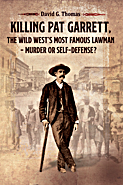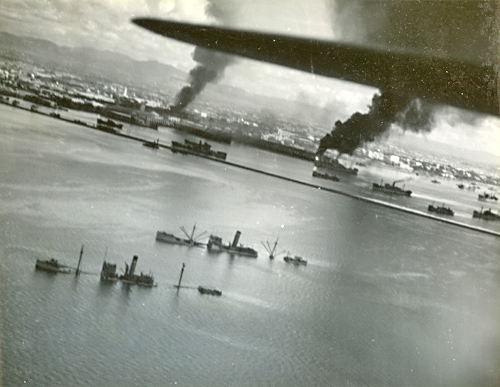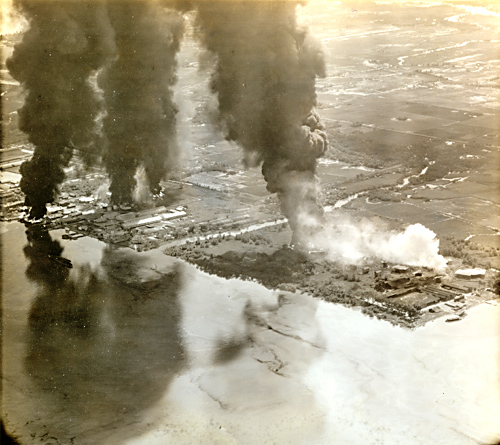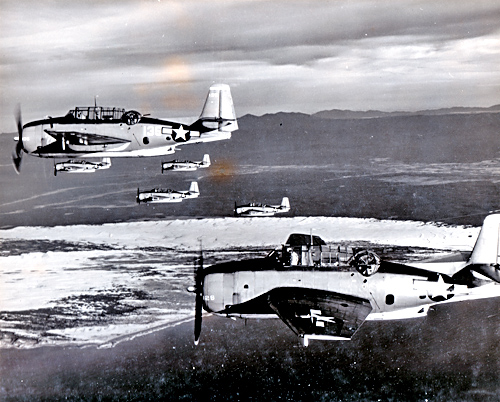|
|
||||||||||||||||||||||||
 |
||||||||||||||||||||||||
|
|
||||||||||||||||||||||||
|
||||||||||||||||||||||||
|
|
||||||||||||||||||||||||
 |
||||||||||||||||||||||||
 |
||||||||||||||||||||||||
 |
||||||||||||||||||||||||
|
|
||||||||||||||||||||||||
|
|
|
|
The Best Section in Torpedo Four |
|
By Page P. Stephens, VT-4 |
||||||||||||
|
During combat operations in the Pacific, I led a 4-plane section with Vernon Landre on one wing and Gerald Thomas on the other. Richard M. Hopfinger flew in the "well" as Thomas' wingman. I considered this section the "best" in the squadron. Training I started on active duty on September 12, 1941 and was commissioned on April 4, 1942. I was fortunate to have completed the 2 Certified Pilot Training courses while I was in college, so by the time I joined the Navy, I had about 100 hours. I learned to fly first in Piper Cubs on floats off of New Meadows Lake in Maine. I also flew Wacos in the secondary course, thereby completing the acrobatic stage. I didn't fly at all in the 3 weeks at elimination base and when I started at Jacksonville, my instructor told me he could put me up for a check any time he wanted to. This he did frequently, so I moved ahead rather rapidly. I did fly a down check when I did an emergency exactly as my instructor had taught me, but the check pilot did not agree and said I should have 2 more hours of instruction. When my instructor heard what had happened, he almost had a fight with the check pilot and even complained to the chief flight officer that he should straighten out the guy. My instructor took me up on 2 quick flights, then persuaded another check pilot to ride with me. That time we flew a scant 15 minutes when the check pilot told me, "You are a good pilot and there is no need to waste any more time," so we landed. That was the only time I had any trouble at all. One thing that helped me a lot was that I had learned celestial navigation when I was in college, so it was a snap. I even taught it at night to guys who did not even know how to start. The North Atlantic I was sitting in the officer's club at Argentia, Newfoundland, listening to the German propaganda broadcast, when the announcement of the Ranger's sinking came on. I could look right out the window and see the ship sitting there at anchor. Evidently, it was just a ploy to get our government to reveal information as to where we were. (See Von Bulow Decorated for Sinking USS Ranger.) We had left Boston about 3 days before and disappeared into the North Atlantic. We actually crossed the Arctic Circle exactly on the Greenwich (0) meridian. This I did not know until some time later. The night before OPERATION LEADER, I was talking with the Skipper and he mentioned that because Jerry (Gerald Thomas) was sick, I might have to take his place the next day. The next day when I saw Jerry, he said that he felt better. My emotions were mixed. I wanted to participate, but I did not want to press my luck. I still think that was the best attitude to take. (See Operation Leader -- The German View.) The TBD planes were really beasts. The pilot's cockpit had four levers right next to each other. They were for (1) raising the wheels, (2) unlocking the wings, (3) folding the wings, and (4) operating the flaps. Our instructions were always to look first to be sure we were moving the right lever. Also, they leaked oil so much that before landing we had to reach out and wipe the windshield. For this we always carried a rag in our flight suit. George W. Wright spun in one night. A destroyer picked him up and took him back to the hospital at Argentia. We went back in the next day and as soon as the ship anchored, some of us went to the hospital to see him. His face was bandaged, but he was sitting up in his bed, smoking. His first words were, "I have things all arranged. There are 5 nurses here who will cook us steaks and bring the rest of the food and we will have a party. You guys bring a few bottles of booze and come back at seven." We followed his directions and had a grand party that night—all in his hospital room. The field at Hatston (Orkney Islands) was a Royal Navy base. The field had beautiful grass and very, very narrow runways. In fact, as we sat in our planes on a runway, we could see only grass on either side. If we saw any runway, we knew the wheel on the other side was off into the grass. Ens Allender (who got vertigo and spun in on March 28, 1944) was a very new pilot in the Air Group. I recall talking with him and discovered that he came from Springfield, Illinois. He was married to the daughter of a lawyer whom I knew. He was very well liked by his squadron mates, and it was very sad to lose him after such a brief duty with the squadron. Cavite and Manila Harbor At the Cavite strike on November 13, 1944, I believe that both Vernon Landre and I were credited with 2 hits each and 2 on the adjoining dock. There were 2 destroyers tied up side-by-side and we dropped our bombs across them at about a 30° angle to their heading. Then, as we climbed out and made a large circle to join up, we could see that the bow of one was slightly under water. The other was burning and clouded with smoke. I always thought this was a fantastic run because we had to make our approach through a light cloud where at times we could not see the target.
Strikes from the USS Essex Concerning my use of the "P" tube, I had mastered the procedure early on. In the torpedo planes, the cockpit hood had to be opened just the right amount or the wind would come back through the tube, spraying the pilot; not a happy situation. In Torpedo Squadron Four, Jerry writes that "During the dive the hatch flew off the turret of one of the Avengers and tore a hole in the stabilizer." This was my plane. A shell exploded nearby causing a concussion, which blew it off. I think my gunner Andy Mocsary was quite shook up, and I didn't blame him at all. Fortunately, the damage to the stabilizer affected the flying of the plane very little, so we landed back aboard with no trouble. This occurred during the strike on Formosa, January 3, 1945. Returning from the Formosa strike, we were climbing on a South heading so we could get high enough to clear the 15,000-foot mountains on the West Coast of Formosa. After clearing the mountains, we headed down, leveling off at around 300 ft. Suddenly 2 Japanese fighters flew overhead, so we went down to the right over the water. At that altitude, the Japanese planes could make only side runs at us, and when they started, we turned in to them to fire our wing guns. Also, our gunners would fire at them whenever they seemed to be getting into range. The planes bothered us only a very short time, then pulled up into the clouds and were not seen again. French Indo-China I was the leader of one of the sections that dropped torpedoes on this strike. I knew mine hit one of the ships that are pictured in the photo. I went right over the top of that ship after dropping. I remember seeing men on the deck most of whom were looking the other way, watching the dive bombers attack another ship. No A/A fire was encountered until I had passed the ship, verifying the fact that our approach was not observed. A later photo showed 4 torpedo hits to that ship. Since the ship was at anchor, this was not a difficult task. In the debriefing, I was not credited with a hit because I was told, "Pilot XXXXXX needs the credit so he can be recommended for a DFC (Distinguished Flying Cross). You already have one." I didn't mind. My satisfaction came from another pilot who saw my torpedo hit the ship. My goal was to be a live veteran.
I saw Willie Walker go down and expected P. J. Davis to stay with him, inasmuch as Walker was his wingman. Davis did not make a move. I thought that someone else in that section would stay with Willie, but no one did. Finally, as I saw him hit the water, I decided that since no one else would, I would stay. I gave the sign to my wingman Landre that I was leaving and dipped my wing slightly. As I glanced to port, I saw Jerry begin his turn, so I quickly straightened up and continued on course. I have always thought that Jerry's sacrifice was outstanding and Davis' decision completely selfish. However, I later learned that Jerry might not have had enough gas to fly clear to the carrier while I certainly did. In my mind, I figured that if I had stayed, Jerry might still have gone in the water, and I certainly would have. In spite of this, I shall always be thankful to Jerry that he turned just a fraction before I started, or otherwise, it would have been I who went in the water. Five VT-4 planes made it back aboard. Two ran out of gas completely, one had about 4 gallons, one had 8 gallons, and I had about 14 left in the tank. My excess was due to several factors. When we first were launched, I had a feeling that this would be a very long flight. I tried to save gas whenever possible and on the return leg I actually exceeded the engine limits to operate at low RPM and high manifold pressure. Also, I did a better job of navigating over the last 100 miles, so the wind did not adversely affect me. As we were returning to the carrier, we were told to land on the first one we came to, and a straight approach was permitted. When I arrived at the Essex, I knew I had enough gas to make a regular approach. I flew by the island and decided to tell the ship I would make a normal approach since I had plenty of gas. I thought I would thereby become famous. However, there was so much chatter on the radio that I could not break in, and it wasn't until I was just ready to take the cut that the opportunity presented itself. At that time, I was too busy landing, so my transmission was never made. Flying back to the ship, the formation spread out. Suddenly, we heard the homing radio from the Essex, which gave us our bearing from it. Scott Vogt immediately announced he had picked it up and could head straight for the ship. I also heard it and figured our exact bearing, working out a heading using the current wind. Vogt took a heading that kept moving him to the right, but I paid no attention. Finally, he started making corrections, which brought him back toward me. He had not figured the wind. I do believe this was one of the reasons I returned with more gas than anyone else. The Bissell/Moore Crash (January 22, 1945) Ens Frank H. Bissell was ahead of us and on our port. I saw him go down very low and the next thing I knew his plane blew up. The bottom of the overcast at that point was about 1,100 ft, so the drop should have been made immediately after clearing the cloud. I recall seeing Bissell and thinking I must not go too low. I think I dropped slightly above 900 ft and immediately pulled back into the cloud. Even so, I could feel my bomb concussion; it felt like an ocean had hit my plane from the rear, giving it a boost. Iwo Jima (February 20, 1945) Chapter 30 of Torpedo Squadron Four does not tell of the flight I made on February 20, the second day of the landings. Riding with me was Kyle Palmer, a correspondent of the Los Angeles Times who was also a Time correspondent. In my VT-4 album, I have a copy of the article he wrote. We circled around for almost 2 hours, watching the operation. We saw the 3 or 4 old battleships that had been sunk at Pearl Harbor, but raised to fight again. They steamed slowly in a line, firing their main batteries in a slow cadence. One occasionally fired a tracer shell that could be seen from the time it left the ship until it buried itself in the volcanic island. The Marines had occupied only a narrow strip about 400 yards and stretching across the island at its narrowest point. They were not quite to the base of Mount Suribachi and were stopped completely. Four small tanks were firing continuously at point blank range. We saw a destroyer that had been run onto the beach with fully 1/3 of its length completely out of the water. Here it could train its forward turret guns (we assumed they were 5 inch) at an upward angle to the caves that covered the mountain. We learned the next day that the destroyer had remained there until early the next morning when a high tide and a tug were able to get it back into the ocean. We could see the 2 hospital ships anchored about 3 miles offshore, busy handling the wounded. Days before, we had been briefed by a Marine that they had anticipated about 10,000 casualties during this operation. Marines´ Flaming Hell on Iwo, by Kyle Palmer, Times War Correspondent. More Kamikazes (March 11, 1945) The night that the Kamikaze hit the USS Randolph at Ulithe, I had a front row seat. I was standing at the rail of the USS Long Island with one of the Air Group's ground officers. We heard the planes circling overhead and my remark was that a pilot must be crazy to fly around here with no lights. Some trigger-happy gunner would shoot him down. Shortly after that, while looking toward the Randolph, we heard a load explosion and saw a ball of fire on the carrier. My friend said, "Oh, my God," and dashed away. Since I already was wearing a belt life jacket, there was no reason for me to go anywhere. I stayed there and watched the Randolph fight the fire. It was fascinating. About 5 minutes later my friend returned. Seems he dashed to his room, realized he could not do anything there, and returned to the rail where I stood. All I said was, "You missed the best part of the show." |
||||||||||||
|
||||||||||||
|
Photo: Page Stephens with crewmen Al Beard and Andy "Marge" Mocsary. |
||||||||||||
|
Air Group 4 - "Casablanca to Tokyo" |
|||
|
|
|||



